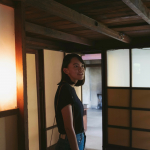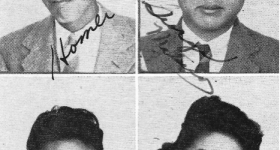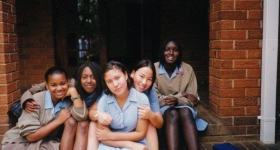Umeboshi (n): Fermented ume fruits common in Japan. While the
The first time I saw umeboshi, dozens of them squished into a jar and sitting on a shelf in my family’s fridge, I screamed. I was maybe 6 or 7, foraging for an afterschool snack, and instead of a juice box, I was face-to-face with bottled-up alien parts, faded red and soaking in what looked like blood.
“It’s plum. It’s a fruit,” my mom explained later as she unscrewed the jar, using her chopsticks to transfer two of the wrinkled masses — one for me, one for her — to a bowl of rice. “Like strawberries.
“Plums are big and juicy,” I protested. “And they’re purple — they’re pretty.”
“These ones are pickled,” my mom replied. “Equal parts salt and sour. Japan knows about balance.” She took a small bite of her umeboshi and rice and closed her eyes. I didn’t know what balance was, but as she quieted, I thought maybe it was happening to her right then. I imagined a swirl of stars and cosmic dust blooming in her belly. Curious, I plucked mine from the bed of rice and dropped it into my mouth.
My brain shouted so many things at once, all jumbled words expressing alarm. It was as if a salty ocean wave had slammed into my open mouth, while my mouth was filled with expired Sour Skittles. My little kid body didn’t know how to interpret the combative flavors, so I spit the umeboshi out into my lap and my mom laughed. Nestled between my thighs and looking sadder and more wrinkled somehow, it resembled my 103-year-old great-grandma, who’d raised 13 children while her husband labored in the sugarcane fields of Hawai’i. Now
I wrapped the umeboshi in a napkin and, when my mom wasn’t looking, slipped it into my pocket. I
–––––––––––––––––––
I swore off all things fermented after that, betting anything pickled would taste just like umeboshi, but I’d later learn almost everything Japanese I ate was, in fact, fermented. Miso
As with most fermented things in Japan, to pickle ume plums is to take something that is naturally good, a product of someone’s hard work, and toil even more to make it better and
The conditions need to be just right to make a decent batch of umeboshi. In Japan, ume plums are to be picked towards the end of June, while they’re still green but relatively soft. They should be sugary, but not too much. There are more than 20 different kinds of ume to choose from in Japan, but the best ume is produced in southern Wakayama. All these factors must be taken into consideration to achieve the right texture and taste.
Despite the initial labor that goes into pickling, there are just three ingredients that you need for umeboshi, besides the plums: sea salt, red shiso leaves and shochu, a Japanese distilled alcohol, though if you’re making it outside of Japan, any vodka will do. Bathe the ume in shochu and salt, let it sit covered until the clear vinegar liquid oozes out, dye them red with shiso and dry them out in the sun.
I didn’t learn about the umeboshi-making process from my mom or my grandmother.
Th
I don’t carry memories shared by my grandma of nostalgic, sticky summers spent making umeboshi with her mother and sisters.
Made up of just two humble ingredients, hinomaru bento was initially consumed by impoverished households and the Japanese army due to wartime rationing.
–––––––––––––––––––
Another thing I’d learned through reading: umeboshi was originally best-known for its medicinal benefits. Ume, like written kanji, was first cultivated in China. There, the fruits were picked while unripe and dried or smoked to be used as Chinese medicine known as ubai. After ume trees were imported to Japan more than 1,500 years ago, they adapted to the new climate and began producing a new species of fruit that the Japanese could claim for themselves. Umeboshi appears in the Ishinpo, Japan’s oldest surviving medical document written during the Heian Period (794-1185), and is prescribed to calm the heart, treat bad skin and alleviate pain.
Quickly, umeboshi gained a reputation in Japan for strengthening stamina and was popular among samurai during wartime in the 16th century. Warriors would carry umeboshi with them into battle, munching on the salted fruits to build up energy before a fight, and then hastily consume them afterwards for a speedy recovery. It is said that the samurai are responsible for the expanse of ume
The relationship between umeboshi and the nation carried on well into the 20th century during World War II, when the umeboshi became a symbol of Japanese patriotism. The hinomaru bento was introduced
Made up of just two humble ingredients, hinomaru bento was initially consumed
Today, you can find hinomaru bento sold alone or with fish and side dishes at any local Japanese market. Marukai, a Japanese market chain in the United States, had a store down the street from where I worked,
Across a gaping ocean, umeboshi was helping another community survive during WWII. After Japan brought the United States into the war with the bombing of Pearl Harbor in 1941, President Franklin D. Roosevelt passed Executive Order 9066, allowing for the forced removal of more than 110,000 Japanese and Japanese Americans from their homes and into camps surrounded by guard towers and barbed wire.
Thousands of American citizens had their lives interrupted, their constitutional rights revoked, and were imprisoned for four years simply for looking like the enemy. Many of them, established in the
When the order went out, nailed into the telephone poles of Japanese American neighborhoods on the mainland, families were only given a week or two, and in some cases, just days to pack their bags and settle their affairs. Furniture was left behind
Families were only allowed to bring what they could carry. For some mothers who had no idea what they and their children would be eating when they got to camp, this meant foodstuffs. One camp survivor I’d interviewed while reporting on a story about WWII incarceration remembered being ordered by his mother to butcher
Cafeteria food at the camps proved to be lackluster and included bland, inexpensive foods like wieners and canned peaches — nothing suited to the Japanese diet, like rice, fresh fish, vegetables and lots of pickled things. According to oral histories of camp survivors, it was common for individuals to bring their uneaten mess hall food back to the barracks to season with furikake, seaweed flakes, or mix with umeboshi to make the food taste a little more like home. A post-WWII archaeology study of Amache, one of the 10 War Relocation Authority camps in Granada, Colorado, found empty glass canning jars in the fields, which could have easily held tsukemono.
In this small way, seasoning one’s cafeteria meals with umeboshi was rebellion. It was a defiant act that said that despite the government’s attempt to criminalize and shame them for being Japanese, here they were, still eating Japanese food — food that made the government’s food taste better.
–––––––––––––––––––
For a long time, I was ashamed of myself for never being able to warm up to umeboshi. My mom loved it, so I wanted to love it. Then I found out Japanese people loved it and had a long history of loving it, and I wanted to love it that much more so I could feel connected to whatever feeling it was that people felt when they ate it. If I truly understood the taste, mulled it over and relished it, I’d be able to understand what it meant to
A few months ago, I moved out of my childhood home and into an apartment, a new chapter in my life that made me feel simultaneously old and childlike. Though I’d been an adult making my own decisions for years now, this physical move to 750 square feet I could call my own made my responsibilities seem heavier. The “future” I’d always learned about in school was here, and anything I said or did would shape it, unravel it in real time.
It was paralyzing, and I dragged my feet when it came to unpacking my boxes. Instead, one of the first things I did was bring home a jar of umeboshi from Marukai, the exact brand my mom always kept at home, and I slid it onto the top shelf of my new, empty fridge. I wasn’t going to eat it. I just hoped it would make things better.










Comments